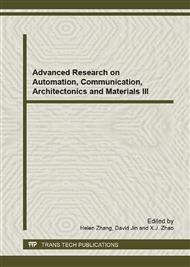p.137
p.141
p.145
p.149
p.153
p.157
p.163
p.167
p.172
Development of Novel Building Materials and Mining System Based on Improved Radio Frequency Identification Technology
Abstract:
A detailed description of the application and performance characteristics of new energy-saving building materials, including the use of new wall material, thermal insulation material, waterproof sealing material. New building materials is different from the traditional brick, gray sand and gravel and other building materials, building materials of new varieties, instead of supporting a variety of various auxiliary materials and chemical materials. RFID tags by coupling components and chips, each tag has a unique electronic coding, attached to the object target object. The paper presents Development of Novel Building Materials and Mining system based on improved radio frequency identification technology. Experimental results show that the proposed method has high efficiency.
Info:
Periodical:
Pages:
153-156
Citation:
Online since:
August 2013
Authors:
Price:
Сopyright:
© 2013 Trans Tech Publications Ltd. All Rights Reserved
Share:
Citation:


